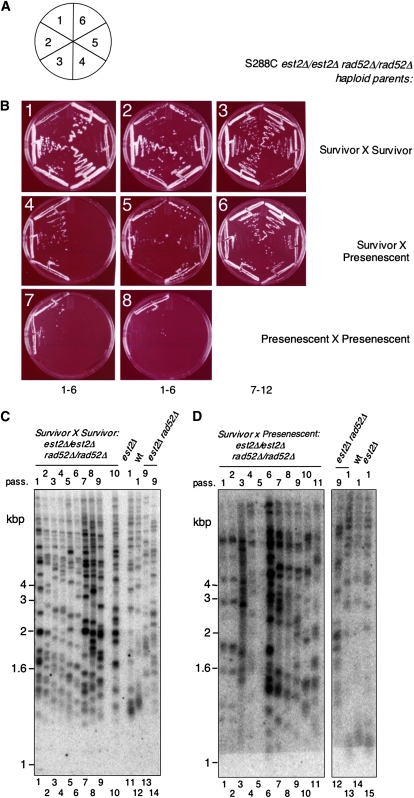Figure 6.—
RAD52-independent survival in diploids generated from RAD52-independent haploid survivors. Freshly dissected S288C est2Δ rad52Δ haploids (“presenescent”) and S288C est2Δ rad52Δ haploid survivors (“survivor”) were mated to generate est2Δ∷est2Δ rad52Δ∷rad52Δ diploid strains. (A) Schematic of the senescence assays on plates, from passage 1 to 6 (see materials and methods). (B) Summary senescence assays of representative diploids grown on plates for the indicated number of passages. B1 and B2, two representative viable diploids from a survivor × survivor cross (passages 1–6), which all survive later passages (e.g., B2–B3). B4 and B5, representative diploids from a survivor × presenescent cross, some of which do not sustain growth beyond 3 passages (e.g., B4), while others remain viable beyond 12 passages (e.g., B5–B6). B7 and B8, two representative diploids from presenescent × presenescent crosses (no diploids sustain growth; therefore there are no data for passages 7–12). See also Figure S4. (C) Telomere Southern blot of genomic DNA. Two S288C est2Δ rad52Δ haploid survivors at passage 9 (lanes 13 and 14) were mated to produce an est2∷NAT/est2∷NAT rad52∷URA3/rad52∷KAN diploid (lanes 1–10, at indicated passages). Lanes 11 and 12, S288C est2Δ and wild-type haploids. DNA was digested with XhoI and the membrane was hybridized to a telomeric probe. (D) Telomere Southern blot of genomic DNA from a “survivor × presenescent” diploid that escaped senescence. An S288C est2Δ rad52Δ haploid survivor (passage 9; lane 12) was mated to a presenescent est2Δ rad52Δ haploid (passage 1; lane 13) to produce an est2∷NAT/est2∷NAT rad52∷URA3/rad52∷KAN diploid (survivor × presenescent) (lanes 1–11, at indicated passages). Lanes 14 and 15, S288C haploids at passage 1 (wt, est2Δ). DNA was digested with XhoI and the membrane was hybridized to a telomeric probe. All samples were analyzed on one gel; lanes between 11 and 12 were omitted. For each panel, marker sizes are indicated at left in kilobase pairs.

